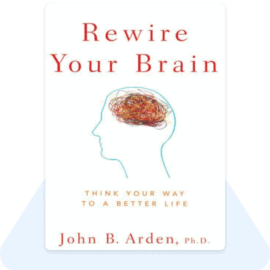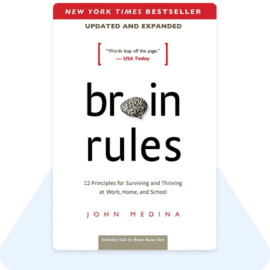Today, we will understand the book “Rewire Your Brain: Think Your Way to a Better Life,” written by “John B. Arden.” Rewiring your brain will teach how certain parts of your brain feel more positive about your life, stay calm during stress, and improve your social relationships.
We all think that we will also die with the mind we are born with. But in reality, our sense is not strong; it is just “software” made by experiences. So we can develop our minds and make necessary improvements in our life.
Those parts of our brain activate; we learn how to do things that have become less active and calm the areas that have become hyperactive. Doing this lets you feel optimistic about your life and stay calm when stressed. And focus on the significant areas of your life.
Chapter 1: Firing the Right Cells Together
According to neuroscientific research, our brain constantly changes, even as new cells are made. And you can also turn your genes on or off with your behavior.
This book will show you how to use neuroscience discoveries to feel calm and positive. To rewire your brain, you must first understand how your brain works. Your brain works in response to and in contact with the world around you.
The brain weighs only three pounds, yet it is one of the most advanced parts of the body. It consists of one hundred billion system cells, called neurons and supporting cells. Neurons are assembled in parts of the brain called modules. For example, in the cortex, four (lobes below the cortex) form the module. “Right brain” people were said to be more creative and spiritual than people with “left brain.”
There is a band of fibers in the brain called the corpus callosum. It works to connect distant neurons. A female’s corpus callosum is denser than a male’s. Due to this, the two hemispheres of the woman’s brain work more and more together.
The right hemisphere pays more attention to the context or essence of a situation. The left hemisphere is better at languages, such as descriptions, categories, and linearly arranged information.
Each hemisphere has four lobes: frontal, parietal), temporal (side), and occipital. Everyone has a unique talent. Women have more neurons in the temporal lobe, so they start speaking early.
The last part of the brain to be mixed is; at the forefront of the frontal lobe, the prefrontal cortex (PFC) gives us our most complex cognitive, practical and emotional abilities.
Significant parts of the PFC include the dorsolateral prefrontal cortex (DLPFC). It involves higher levels of thinking, attention, and short-term memory.
More than sixty types of neurotransmitters are present in the brain. Some excite you, and some calm you down. The three most commonly discovered neurotransmitters are serotonin, norepinephrine, and dopamine.
Serotonin plays a role in emotional tone and many different dynamic processes. Low serotonin levels are related to anxiety, depression, and even OCD. Norepinephrine activates attention. Dopamine helps with concentration. Neuroplasticity makes up your memory. By making connections between thoughts or pictures, you also make connections between the neurons that make up your memory.
The more you do something in a specific way, use words with a particular pronunciation or remember something about your past, the more neurons work together to strengthen your connection.
The more you do something, the more you can place it in the future. You can rewire the mind only by learning new information and creating fresh talent. Along with this, you can adopt these four methods to rewire the mind:
1. Attention:
Pay attention to the behavior or memory you want to repeat or remember. Meditation activates your frontal lobes, allowing you to remember things. Remember, your brain cannot remember millions of things, so pay more attention to what you want to remember. Meditation brings you to the present situation, and this starts neuroplasticity.
2. Effort:
Try with focus this activates the brain to make new synaptic connections. When you start trying, your brain uses too much glucose to learn something new. And the part of your brain associated with that work begins working through the scan.
3. Effortlessness:
Once a new behavior, thought, or feeling is formed, it requires less energy to continue. In the beginning, it takes focus, effort, and more power in your mind, but it becomes easier when you understand the methods and practice consistently. And once you develop a technique, your mind is ready to do that thing comfortably.
4. Persistence:
The last way to rewire your mind is to keep practicing. For this, keep doing that thing repeatedly in which you want to be good. By working with determination, you can complete the process of rewiring your mind.
Chapter 2: Controlling Your Amygdala
Many of us are unable to express our feelings or thoughts openly. Because of this, they are unable to understand their point. If you also have such a problem, you have to control your amygdala.
To do this, you have to first focus on the pleasant aspect. And start with talking to people who like to listen to you – this can engage your frontal lobes, which will help rewire your brain.
Now adopt the four methods mentioned in Chapter 1 to rewire your brain/mind: Focus, Effort, Effortlessness, and Determination. Practice speaking as much as you can; eventually, you will be able to control the amygdala and overcome the fear of speaking in public. Also, use these methods to cope with your stress and anxiety:
- The amygdala can also threaten you if you fear, giving you dangerous diseases. It may also happen – so as soon as you feel like this, react to your feeling and do something else to change it.
- You have to find a middle way to deal with the stress. Do not try to run away from stress and anxiety; organize it. Doing this can promote a healthy, valuable mind.
- When your heart rate is fast, you are under more stress. So slow down your breath. To learn to relax, create some new breathing habits. You can meditate on this.
- Face the fear instead of trying to avoid it. When you learn to face your fear, you can easily overcome your fear.
- Don’t rely on negative things. Think positively because how you feel – can cause your emotional state. Negative thoughts always cause you to worry. Positive reviews make you happy.
Chapter 3: Maintaining a Positive Mood
It can seem like a record if you have an old emotional foundation that keeps you feeling sad or angry, it can seem like a record. To change this, you have to stop thinking the way you were thinking before.” At the same time, you must find ways to let go of that negative feeling. Rewire your mind to promote a positive mood. There are several ways that we will learn about in this chapter:
1. Positive Mood:
If you cannot easily stay in a positive mood, you can even restart your mind by pretending to be in a positive attitude to think that you are in a perfect mood. If possible, always keep a smile on your face. Pretending to be happy can also bring you a lot of benefits.
Here’s how it works: Our body’s neural pathway connects the facial muscles, cranial nerves, subcortical regions, and cortex. So the information travels from the brain to the face, and you feel happy. and you are able to rewire your brain.
2. Light Chemistry:
To use this method, make the most of the natural light that comes during the day. So that you can help your brain chemistry to promote good feelings, natural light refreshes you. Along with this, you can also take a tablet of vitamin D, which is necessary for your defense system.
3. Aerobic Boosting:
Research has shown that exercise is one of the easiest ways to promote neuroplasticity and neurogenesis. For now, just remember that when you combine training with changing the way you think, your mood can powerfully boost.
4. Creating Narratives:
Be yourself, the Narrative of your life. Try your best to explain your life. It helps you understand your experience. And you can achieve positive emotions.
5. Positive Thinking:
You must keep the CBT target in your mind for positive thinking. By doing this you c, you can “correct” your lazy thoughts and also change your feelings. In CBT, you repair your cognitive distortions. If you’re depressed, you’re probably stuck with cognitive distortions or beliefs that promote negative moods. Cognitive distortions are:
- Polarized thinking: black and white, all or nothing, good or bad, unique or lousy thinking.
- Overgeneralization: Concluding one’s life by thinking about a bad incident at work.
- Personalization: Taking what someone has said negatively.
- Mind Reading: Negatively assuming that you know what other people are thinking.
- Should and shouldn’t: Making strict and strict rules.
- Accident: Understanding any event as a sign of a significant disaster or one on the way (e.g., “Oh, no, a red light! I can’t go now.”)
- Emotional reasoning: on how you feel, make an opinion.
- Pessimism: Seeing negative consequences for most events.
Such negative thinking affects your mood and makes you depressed. You can make your attitude positive by changing the way you think. Use this thinking to get your mind out of a negative attitude to rewire your brain successfully.
- Gray: Thinking this way can help you counter negative and positive thinking. Just start thinking about all the expectations in between.
- Investigate it: Now, instead of just following your predetermined opinion – include your statement and assumptions about the situation.
- Optimist: Treat every situation as an opportunity.
- Isolating: Disconnect yourself from repetitive negative beliefs.
- External Problems: When something terrible happens, consider it a problem rather than your fate or future.
- Social therapy is the easiest way to create a positive mood. You get out and spend time with people. Loneliness is the most significant cause of sadness. So start living with people and see the difference in no time.
Using all these methods, you can positively change your mood. And again, when you face a negative attitude, be ready to shift your mindset positively away. In this way, you can rewire your mind to think positively.
Chapter 4: Improving memory
Think about a good life; it is always necessary to feel well. But often, we have such a memory that we are forced to think badly. So rewire your memory in such a way that it can help you to feel better. And to do this, you need to develop memory in a better way. You can do a lot to improve your memory. But it also has some constraints:
- Focusing on several things and remembering them all with great accuracy. For example, this is why you may need to remember to look at the correct road sign while driving if you are talking on your cell phone at the same time.
- You are expecting your memory to improve without any effort. Memory is not something you have or don’t have, like an inheritance. Exercise is necessary to increase memory.
- It is believing that you will remember everything you have ever experienced. Memories are not like snapshots. Therefore, the old monument becomes weak when a new remembrance is formed.
Methods to enhance your memory:
1. Careful:
Paying attention is a function of your frontal lobes. They tell the rest of your brain what is important and what needs to be remembered. You need to engage your frontal lobes to promote neuroplasticity and improve memory. To build a good memory, keep these things in mind:
Only through meditation can you strengthen your memory because we can often remember the same thing for a long time on which we have given our full attention. The more critical a piece of information is to you, the longer your memory will last.
2. Using different types of memory:
There is a limit to the amount of memory you can store in your working memory, while you can keep countless memory in your long-term memory. Long-term memory is like a collection. It is called declarative memory if you remember some events, information, picture, or any subject about your past.
The memory of data based on language is called semantic memory. The overlapping memories of the past are called episodic memory.
Consider the method of memory with this example. If you remember to cut a paper, it is episodic memory. If it reflects how you cut the article, it is declarative memory. It is semantic memory if you remember the words someone said about a paper cut. If your memories include strong emotions, they are called emotional memories. For example, a habitual walking style, such as cycling or writing your name, is called procedural memory.
All these types of memory are considered forms of long-term memory, yet they can be viewed as two extensive subsystems, Explicit and Implicit memory. Explicit includes things and declared experiences. Implicit have procedural skills and emotional memory. Procedural skills the neuroplasticity involved in your long-term memory becomes by following three of these methods:
1. Recalling: Sometimes, this is called coding a memory. For example, learning the basics of riding a bike happens.
2. Storing memories: At this stage, you file the memory for later use as you work on learning to ride.
3. Gaining Memory Back: You remember to run the next time you get on the bike.
4. Helpful and memory enhancement tricks: You can develop memory skills using memory enhancement tricks. The mnemonic devices are the ones that grab your attention and make memorizing fun. They are the most effective. Some mnemonic devices have been used throughout history, four of which the author has described as essential and easy to understand:
1. Pegs: This allows you to associate one word with another which is easier to remember. When you think of the phrase peg, you’ll think of the word you want to remember.
2. Loci: Loci are the plural word for locus, used for “place” or “location.” When you are using Loci, mark your memories with a special place. Use Loci’s two main methods for this: Commit to remembering a place in the order that you remember them.
Pair something with every single place you want to be remembered for. By taking these two easy methods, you can remember what you’re trying to remember by looking at the place, walking over it, or simply imagining it in your mind.
3. Story Links: Throughout history, people lived around storytellers. You may have read many books and enjoyed many movies. Stories are an essential part of our culture. You use stories to learn, teach, and pass the time. You can also associate stories with information you want to remember.
4. Link: It takes a little more time to build. To use this technique, create a list or group of words or concepts you need to remember. To use the link technique, link a viewed picture to something you want to remember.
Now use the memory system best suited for you. Remember that whatever memory system you use is flexible for you, and you can easily remember the things you try to remember. Also, practice using mnemonic devices so that you can get better at using them.
Also, keep these things in mind to improve your memory:
- Eat a balanced diet: To have a balanced diet, include one complex carbohydrate, one fruit or one vegetable, and one protein in your diet.
- Get enough sleep: To utilize your total memory capacity, a calm and alert mind is needed. This can be achieved only by rest, so take full sleep of 8 – 9 hours.
- Exercise daily to enhance your memory.
- Take Supplements. Vitamins, minerals, and herbal supplements help your brain acquire biochemistry, which allows you to remember well.
- Use mindfulness exercises as a way to keep your memory skills sharp. For this, consider these things: Read non-fiction books. Take a class. Travel. Engage in inspirational conversations and discussions. Develop your attention span: For this, complete your daily work perfectly and well. Be organized and always ready to figure things out. Pay attention to someone’s name, shape, and color, as well as their smell, voice, and feelings when you meet them. Use the four mnemonic devices mentioned earlier: Pegs, Loci, Story Links, and Links.
Rewire the Mind in Healthy Habits
Our brain often becomes weak due to our bad habits. And to strengthen your mind, it is essential to change these habits. These bad habits include eating the wrong food, skipping food, not getting enough sleep, or wasting your time. All these bad habits harm your mind, due to which you start doing negative things in your life. So to convert these bad habits into good habits, keep some essential things in mind:
- Never miss even one meal out of your three meals. Especially never skip your breakfast because breakfast in the morning helps to make you energetic. You can quickly and enthusiastically thank better when you start your day with all your energy. So start the morning with an active and healthy breakfast. To make breakfast better, include an egg (protein), whole grain (carbohydrate), and juice (fruit) in your breakfast. For lunch, eat a meal that is higher in protein than carbohydrates. Keep your dinner opposite the day, and remember that your feeder should be more elevated in carbohydrates than protein. Then do not eat anything before sleeping in the evening.
- Avoid overeating sugar. This is bad for your brain because it impairs your ability to think clearly, maintain your mood and behave effectively in social standing. So keep your blood sugar balanced.
- If you have good short-term memory and intellectual acuity during the day, eat breakfast or lunch with high protein. Eat foods that contain amino acids – because amino acids activate: acetylcholine, norepinephrine, and dopamine, which improves the ability to remember.
- Do exercise daily. Start walking for 15 to 20 minutes every morning if you can’t exercise much. Along with this, meditate. Meditation will help your mind to be calm and think well. Do not exercise too much at once. This can make you tired, directly affecting your brain and making you sad and depressed.
- Bad sleeping habits can cause many diseases, and your brain can become very weak. To improve your sleeping habits and follow these instructions to create a healthier sleep pattern:
- Don’t do anything in bed other than sleep and have sex.
- If you can’t sleep, get up and go to another room.
- Don’t try too hard to sleep. This will increase your stress.
- Avoid drinking too much fluid at night.
- Avoid bright light for at least a few hours before bedtime. Do not work on the computer till late evening.
- Avoid naps throughout the day. Rest can lead to a good night’s sleep.
- Try to eat a light breakfast with complex carbohydrates before bedtime. But don’t eat anything with sugar or salt.
- Avoid protein snacks at night, as protein inhibits serotonin synthesis and makes you alert.
- Exercise three to six hours before bedtime, and use earplugs or a white fan to avoid noise.
- Do not drink alcohol five hours before bedtime.
- Keep your body temperature cool. Don’t cover yourself too much.
Also, take care of all the essential things mentioned in the book and start working on rewiring your mind.
Conclusion & Review
From this book, we learned about how to rewire the brain, using which you can start a better life. You do the essential things in your life the way you think – plus your mind influences the most important aspects of your life. This means your thinking, good or terrible, depends on your mind. And it is essential to have a solid reason to think well. So use the methods mentioned in the book to achieve a strong sense and improve your life. I hope you have understood this book well and you will use the methods mentioned in the text in your life.
As someone who has struggled with anxiety and depression for years, I was always looking for ways to overcome my negative thought patterns and improve my mental well-being. This book gave me the tools and knowledge I needed to make significant changes in my life.
One of the things that stood out to me was the author’s explanation of how the brain works and how our thought patterns can become ingrained in our neural pathways. Arden explains how we can rewire our brains by changing our thoughts and behaviors and provides practical exercises and techniques for doing so. I found these exercises to be very helpful, as they allowed me to see the impact that my thoughts and actions were having on my brain and overall mental health.
Another aspect of the book that I appreciated was the author’s emphasis on the importance of self-care. Arden explains how stress and negative emotions can have a detrimental effect on our brain health, and provides tips for reducing stress and promoting self-care. This was particularly helpful for me, as I tend to put others’ needs before my own and neglect my own well-being.
Overall, I would highly recommend “Rewire Your Brain” to anyone who is looking to improve their mental health and well-being. The book is written in an accessible and engaging way and provides practical tools and techniques that can be easily implemented in daily life. It has undoubtedly had a positive impact on my own life, and I am grateful to have come across it.
Contents














This book comes across as more “self help” type than scientific type. I found that despite his ability to describe things with fancy scientific names, there was no real new information here. Get lots of sleep, eat well, and exercise .